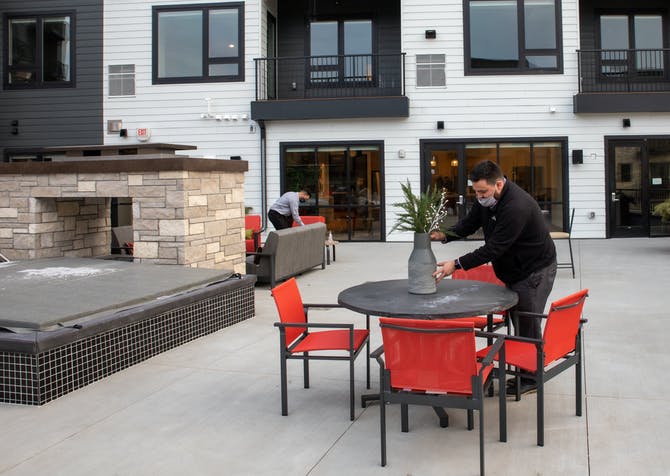COVID-19 is altering Minnesota commercial real estate in subtle ways — from a boost in office subleases to quick construction pivots to adapt offices and apartments to allow tenants to safely gather outside in the winter or toil away indoors.
Doran Cos. was building its new Birke apartment complex in Minnetonka last summer when the coronavirus forced it to rethink its "amenities deck."
With the Centers for Disease Control and Prevention advising that people avoid socializing indoors, the developer scrapped original designs and opted to heat the deck concrete to allow 125 future tenants to more comfortably use the outdoor BBQ grills, hot tub, fire pits and seating well into December and January.
The change was a first for Doran but is one in a growing number of COVID pivots that building designers are making to cope with a pandemic that is not expected to be completely eradicated for months, even as vaccines roll out nationwide. Many design changes are adding tens of thousands of dollars to construction projects, but not breaking the bank.
Still, the effects of COVID-19 are expected to last for years as office and factory workers, baristas, nurses aides and apartment tenants continue to look for built-in safety measures.
Minnesota building owners quickly installed touchless elevators, hand-sanitizing stations, temperature check-ins and new air-filtration systems during the early days of the pandemic. But now that the virus cases have surged, developers are adding shower rooms, private offices and heated three-season outdoor patios across Minnesota.
Builders are asking themselves, "What are the long-term impacts of COVID?" and then altering their plans, said Doran President and Chief Executive Anne Behrendt. Many are also careful to ask, "Are we going too far with design changes that are reacting to COVID, but that in two or three years may not be how people really want to live and interact?"
The Building Owners and Managers Association estimates only 10 to 15% of Minnesota workers have returned to the office so far. With that percentage not expected to escalate dramatically until well into 2021, it pays for some developers to embrace their COVID construction changes now.
Even with COVID's uncertainty, "You are probably building what still will be utilized for years to come," said Sam Newberg, senior field research analyst at property management and leasing giant CBRE and a BOMA member.
Some Transwestern office-lease clients in Minnesota recently expanded conference rooms thinking they will need bigger collaborative spaces post COVID-19.
The idea being that employee's "individual work" will continue to be done from home while collaborative or project work will be the thing that draws staffers back to the office in clumps even after the virus subsides, said Transwestern Principal Erin Fitzgerald.
Of its 12 Twin Cities projects, Doran Cos. pivoted again this month, changing the blueprints for a Richfield apartment complex going up next to Lunds & Byerlys. Designers dumped plans for an open business center in the lobby and are instead building three individual offices.
Seeing the demand swell for apartment workspace during COVID, Doran added more indoor and outdoor co-working spaces for a Tonka Bay luxury apartment complex now under construction.
"Post-COVID, the only thing that will stick around is people will continue to work from home," said Tony Kuechle, Doran president of development.
Subtle COVID changes are also altering buildings where the workforce can't work remotely.
Oppidan Investment, the senior-housing developer that broke ground on its sixth senior-housing complex in Minnesota one month ago, is adding a screening/locker room with showers for staffers at each of its new properties because of the pandemic. The room will become the new entrance for all staffers.
"We are doing that in Grand Rapids [Minn.] and in all of our [other] new communities," in California and on the East Coast, said Oppidan President Blake Hastings. "It's another step to keep [our workers] safe. So if they are concerned about bringing anything [virus-related] home, they can shower on site and change clothes before leaving work. It gives them a place to decompress and allows us a place to screen these teammates [before] coming into work."
Oppidan is also adding sinks in its resident hallways so aides can wash hands more frequently, Hastings said.
The vaccine won't be widely available for months so this is "the right thing to do," even if it costs more, Hastings said, noting that each new staff locker room will cost the same as adding one senior apartment to each building.
Offices, factories and other industrial builders are taking a different page from health care property managers and installing hospital-grade heating and air-conditioning systems (HVAC) that also purify the air. Murphy Warehouse in Minneapolis recently installed sterilizing UV lights in all its rooftop air systems. Those who sell the units are swamped with inquiries.
"We are definitely selling and shipping more units with the higher-efficiency filters today than ever before and we are shipping orders with the [air-sterilizing] UV lights definitely more than ever before," said Jim Macosko, product general manager at HVAC-maker Daikin Applied Americas.
Daikin, a Japanese firm with two factories in Faribault and one in Owatonna, sees demand spiking for three technologies it can embed in its Minnesota-made HVAC systems. It's using more Merve 13 and 14 air filters or embedding UV lights to trap or kill germs.
Separately, it's also starting to install bipolar ionization equipment in some HVAC systems. Ionization electrically charges air particles and neutralizes bacteria and viruses.
Daikin has yet to install the systems at its own Minnesota factories but has bolstered air-exchange rates and now runs air filters 24/7 — not just during work hours, Macosko said.
Even with the arrival of a coronavirus vaccine, high-tech air-purification systems will not fall out of favor after COVID-19 is gone, he said. After all, "COVID won't be the last virus we have."

